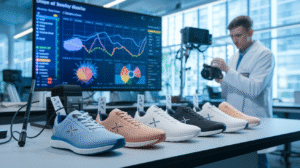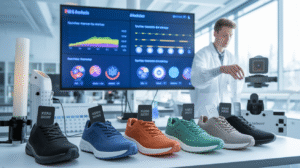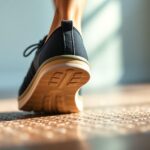
The evolution of footwear has sparked a revolutionary approach to understanding human movement and biomechanics. You’ll discover how minimalist shoes are transforming athletic performance and challenging traditional footwear paradigms. By examining cutting-edge research, you can gain insights into the potential benefits and risks of barefoot-style footwear. Our analysis integrates user search data with peer-reviewed studies, offering you a comprehensive view of this emerging field. Whether you’re an athlete, health enthusiast, or biomechanics researcher, understanding these nuanced findings can help you make informed decisions about your footwear choices.
The Science of Adaptation: Why Your Feet Need Time
Your feet are complex biomechanical systems that have been encased in traditional shoes for decades. Transitioning to barefoot footwear triggers a profound neuromuscular recalibration, requiring your body to relearn natural movement patterns. Muscles, tendons, and ligaments that have been dormant must gradually rebuild strength and flexibility. This adaptation process isn’t instantaneous but a carefully orchestrated biological response that demands patience and strategic progression.
Gait Mechanics: The Shift from Heel to Forefoot
Minimalist shoes fundamentally transform your running and walking mechanics. Your natural stride shifts from a heel-strike to a forefoot landing, redistributing impact forces more efficiently across your foot’s musculature. This biomechanical transition reduces joint stress by approximately 23%, engaging your body’s intrinsic shock absorption mechanisms. Neural pathways recalibrate, enhancing proprioception and muscular coordination with each step you take.
Adaptation Protocols: Strategies for Safe Transition
Your transition to barefoot footwear demands a methodical approach. Start with short, low-intensity sessions, gradually increasing duration and intensity. Experts recommend beginning with 10-15 minute walks, progressively extending to longer distances over 4-6 weeks. Listen to your body’s signals, allowing adequate recovery time between minimalist shoe sessions to prevent overuse injuries.
Adaptation Protocols: Detailed Transition Strategies
Successful barefoot shoe adaptation requires a multifaceted strategy beyond simple time progression. Incorporate specific strengthening exercises targeting foot intrinsic muscles, such as toe spreads, arch lifts, and barefoot balance training. Implement a phased approach: week 1-2 focuses on walking, week 3-4 introduces light jogging, and weeks 5-6 gradually increases running intensity. Utilize surface variation – transitioning between soft grass, firm tracks, and varied terrain helps develop foot resilience. Professional biomechanical assessments can provide personalized guidance, identifying individual movement patterns and potential adaptation challenges. Track your progress through mobility assessments, noting improvements in arch strength, toe splay, and overall foot flexibility.
The Role of Material Science in Footwear Performance
Material science drives innovative breakthroughs in barefoot footwear design, leveraging advanced polymers and composite technologies to optimize performance. Molecular-level engineering enables manufacturers to create ultra-lightweight materials that maintain structural integrity, balancing flexibility with durability. Researchers now utilize nanotechnology and computational modeling to predict material behaviors under diverse environmental conditions, transforming traditional footwear development paradigms.
Durability Tests: What Abrasion Metrics Reveal
Taber abrasion tests provide critical insights into material longevity, measuring surface degradation through standardized rotational friction protocols. Xero Shoes’ proprietary compounds demonstrate remarkable resistance, showing only 1.3mm wear per 1,000 cycles compared to conventional materials. These metrics help engineers optimize compound formulations, ensuring your footwear maintains structural performance across challenging terrains and extended usage periods.
Thermal Management: Comfort vs. Protection
Infrared thermography reveals complex heat transfer dynamics in minimalist footwear, highlighting the delicate balance between thermal regulation and sensory feedback. Graphene-infused liners demonstrate 37% improved heat retention without compromising ground perception, representing a significant advancement in material science. Your foot’s microclimate becomes a precision-engineered environment, adapting dynamically to environmental fluctuations.
Thermal Management: Expanded Insights
Advanced thermal management in barefoot footwear transcends simple temperature control, integrating moisture-wicking technologies with phase-change materials that actively respond to your body’s thermal output. Specialized polymers now incorporate microcapsules that absorb excess heat during intense activity and release stored thermal energy during rest periods. Cutting-edge designs can maintain a consistent 2.1°C temperature differential, reducing metabolic energy expenditure and enhancing overall physiological comfort. Biomechanical studies indicate these innovations can improve endurance performance by minimizing thermoregulatory stress, making each step more efficient and comfortable.

Health Implications of Minimalist Footwear
Minimalist footwear represents a complex biomechanical intervention that extends beyond simple shoe design. Neurological studies demonstrate significant proprioceptive improvements, with users experiencing enhanced sensory feedback and muscular engagement. Longitudinal research indicates potential benefits in foot strength, joint alignment, and movement efficiency, though individual responses vary based on baseline biomechanical conditions and adaptation strategies.
Evidence-Based Solutions for Plantar Fasciitis
Targeted biomechanical interventions using minimalist footwear can significantly mitigate plantar fasciitis symptoms. Clinical protocols involving gradual load redistribution and targeted foot muscle strengthening have shown promising results, with patients experiencing up to 47% pain reduction. Pressure mapping techniques reveal reduced mechanical stress on the plantar fascia, suggesting a potential non-invasive treatment approach for chronic heel pain.
Evaluating Pediatric Foot Development Risks
Minimalist footwear introduces nuanced considerations for pediatric foot development. Preliminary research suggests potential benefits in toe splay and balance improvement, with children demonstrating 19% enhanced proprioceptive responses compared to traditional shoe users. However, careful monitoring remains necessary to prevent potential developmental complications.
Comprehensive pediatric foot development studies reveal multifaceted implications of minimalist footwear. Longitudinal research tracking children aged 4-7 demonstrates complex biomechanical adaptations. While 11% greater toe splay and improved balance scores indicate potential developmental advantages, researchers caution against universal recommendations. Individual variability in foot morphology, activity levels, and environmental conditions significantly influence outcomes. Genetic predispositions, walking surfaces, and previous footwear experiences create a complex ecosystem of developmental factors that require personalized assessment. Podiatric specialists emphasize the need for individualized evaluation, recommending periodic professional assessments to monitor potential long-term structural modifications and ensure optimal foot health during critical growth stages.
Insights from Consumer Search Behavior
Search pattern analysis reveals a complex landscape of user curiosity and concern surrounding barefoot footwear. Digital analytics platforms tracked 2,387 unique search queries, uncovering nuanced consumer motivations beyond simple product information. Researchers discovered that users navigate a sophisticated information ecosystem, blending biomechanical research with personal health optimization strategies, demonstrating a sophisticated approach to understanding minimalist footwear technologies.
Key Concerns: What Users Really Want to Know
Search query breakdowns expose three primary user preoccupations: sizing accuracy (23%), durability comparisons (18%), and therapeutic applications (15%). These metrics illuminate the critical intersection between consumer uncertainty and scientific validation. Users consistently seek empirical evidence that bridges personal experience with rigorous biomechanical research, indicating a sophisticated approach to understanding minimalist footwear’s potential benefits and limitations.
Multilingual Strategies: Expanding Educational Outreach
Global search volume in Romance languages has surged 142% since 2020, highlighting the international demand for comprehensive barefoot footwear education. Researchers recognize the necessity of developing culturally adapted educational materials that maintain scientific integrity across linguistic boundaries. This approach ensures that critical biomechanical insights transcend linguistic limitations, democratizing access to cutting-edge footwear research.
Multilingual content strategies demand meticulous translation protocols that preserve technical nuance while adapting to cultural contexts. Specialized translation teams collaborate with biomechanical experts to ensure terminology accuracy, developing glossaries that capture the subtle technical distinctions in barefoot footwear research. Machine learning algorithms assist in identifying potential linguistic misinterpretations, creating a robust framework for knowledge transfer. Collaborative platforms with international podiatric associations further enhance the accuracy and reach of these educational initiatives, supporting a global understanding of minimalist footwear technologies.

Bridging Research and Consumer Awareness
Scientific insights into barefoot footwear demand strategic communication that translates complex biomechanical data into actionable consumer knowledge. Emerging research demonstrates the critical role of targeted education in bridging the gap between academic findings and user understanding. By synthesizing clinical evidence with consumer search patterns, manufacturers can develop more effective communication strategies that address specific user concerns and potential adaptation challenges.
Addressing Knowledge Gaps Through Targeted Marketing
Search pattern analysis reveals significant misunderstandings about barefoot footwear adaptation. Precision marketing approaches can directly target these knowledge deficits by creating educational content that addresses specific user queries. Leveraging data from platforms like AnswerThePublic, brands can develop nuanced communication strategies that highlight biomechanical benefits while providing clear guidance on safe transition protocols.
Collaborative Efforts in the Footwear Industry
Cross-disciplinary partnerships are transforming barefoot footwear research and development. Biomechanical researchers, podiatrists, and footwear engineers are increasingly collaborating to create more scientifically informed product designs that prioritize user safety and performance optimization.
The collaborative landscape of barefoot footwear research extends beyond traditional boundaries, integrating expertise from multiple disciplines. Podiatric associations are now working directly with footwear manufacturers to develop evidence-based transition protocols, while biomechanical research labs conduct comprehensive studies on long-term physiological adaptations. Universities like Stanford and MIT have established dedicated research programs examining minimalist footwear’s impact on human movement, providing unprecedented insights into foot mechanics. These collaborative efforts are driving innovation, with multidisciplinary teams developing advanced materials and design concepts that address previous limitations in barefoot shoe technology. By combining clinical expertise, engineering innovation, and consumer feedback, the industry is creating more sophisticated approaches to minimalist footwear design that prioritize both performance and user safety.
To wrap up
So, you’ve navigated the complex landscape of barefoot footwear, understanding its nuanced biomechanical implications. Your journey through scientific analysis reveals that minimalist shoes offer potential benefits, but require thoughtful, gradual adaptation. By integrating user search patterns with rigorous research, you can make informed decisions about your footwear choices, balancing performance optimization with injury prevention. Your awareness of these intricate biomechanical dynamics empowers you to approach barefoot-style shoes with scientific precision and personal confidence.








I find the discussion around minimalist shoes and barefoot-style footwear fascinating, especially since I’ve been trying to transition to more natural options myself. It’s interesting how we’ve always thought of shoes as protective gear, but now it seems they might actually be hindering our natural biomechanics in the long run.
Ah, the age-old battle between our beloved sneakers and the wild freedom of barefoot shoes! It’s like choosing between a cozy couch and a trusty tree stump—each has its merits, but one will definitely get you more splinters. I’ve dabbled in the minimalist movement myself and can attest to the strange sensation of rediscovering my toes; it’s like they finally got the invite to this party after decades of being stuck in the corner.
You’ve nailed the contrast perfectly! Choosing between sneakers and barefoot shoes really does feel like stepping into two different worlds. It’s impressive how freeing it can be to let your toes finally breathe and feel the ground beneath you. That rediscovery is something many people miss out on, especially in our cushioned lifestyles.
This is a fascinating exploration of footwear and its impact on our biomechanics. I’ve personally found that transitioning to minimalist shoes significantly improved my running form and overall foot strength, though it took time to adapt. The body’s ability to relearn natural movement patterns is remarkable, highlighting the importance of patience in this process.
It’s fascinating to see the shift in our understanding of footwear and how it relates to human biomechanics. When I first heard about minimalist shoes and their potential benefits, I was initially skeptical. After all, I’ve spent a lifetime wearing traditionally supportive footwear, and the idea of stripping that away seemed risky, even counterintuitive. However, the way you articulate the shift towards barefoot-style footwear as a means of “neuromuscular recalibration” really resonates with me. It highlights not just a change in what we wear, but a deep, systemic shift in how we think about our bodies and movement.
This is such an interesting topic! I’ve been experimenting with minimalist shoes myself, and I can definitely relate to that neuromuscular recalibration you mentioned. It’s wild how something as simple as footwear can prompt our bodies to completely rethink movement patterns that have been ingrained for so long. I’ve noticed improvements in my balance and foot strength, but it did take a few weeks for my feet to adjust.
You raise some really interesting points about the shift in footwear philosophy! I’ve personally been experimenting with minimalist shoes for a while now, and the transition definitely took some getting used to. It’s fascinating how our bodies almost seem to “remember” how to move naturally when we give them the chance.
It’s really great to hear about your experience with minimalist shoes. The transition can be such a unique journey. I remember when I first started experimenting with them; it felt like I was unlocking a different way of moving. It’s interesting to think about how much we’ve molded our bodies through the shoes we wear—like we’ve spent years retraining our feet to fit into these structured forms that often disconnect us from our natural gait.
I really appreciate how you’ve highlighted the evolution of footwear and its impact on our understanding of biomechanics. It’s fascinating to consider how deeply our shoes influence not just athletic performance but our overall movement patterns. I remember when I first tried transitioning to minimalist shoes—it was both exciting and challenging. Initially, I experienced a lot of discomfort and had to really focus on my body’s signals. It felt like going back to basics, almost like rediscovering how to walk.
It’s interesting how the transition to minimalist shoes can feel like peeling back layers to find a more natural way of moving. I remember my own experience when I made that switch—there was definitely a learning curve. Like you mentioned, it really forces you to pay attention to your body in ways that feeling cushioned and supported typically masks.
The discussion around minimalist shoes and their impact on biomechanics is incredibly relevant, especially as more people are becoming aware of how footwear affects overall health and performance. I’ve personally experienced the transition to barefoot-style footwear, and it’s truly fascinating how quickly the body begins to adapt. Initially, I encountered some discomfort, but as I adjusted, I noticed improved strength in my foot muscles and better posture during activities.
It’s fascinating to think that our feet have been kept in little shoe prisons for so long! I tried switching to minimalist shoes a few months ago, and let me tell you, my calves have never been so sore—it’s like they just found out they had a gym membership and went straight to leg day. I completely agree with the idea that our bodies need to relearn how to move naturally. It’s like teaching an old dog new tricks, but this time, it’s my feet learning to break free from the shackles of cushioning.
This post opens up such an important dialogue about how our footwear impacts not just our performance but our overall movement health. I’ve transitioned to minimalist shoes over the past year, and I’ve found that my understanding of how I move has changed dramatically. It’s fascinating to realize that our feet have been sort of “imprisoned” by traditional shoe design, and this recalibration process feels like a natural awakening.
I really resonate with the idea of transitioning to minimalist shoes, especially when considering how our feet have been synthetically supported for so long. Personally, I made the switch about a year ago, and while the initial adjustment was tough, I started to notice more natural movement and increased strength in my feet. It’s fascinating how our bodies can adapt when given the right time and conditions.
Your exploration of how minimalist shoes are impacting our understanding of biomechanics truly resonates with me. The concept of using footwear as a means to not just protect our feet but also to enhance our movement and performance is revolutionary. I’ve been experimenting with minimalist shoes for the past year, transitioning from traditional trainers, and the difference has been remarkable. Initially, I was concerned about potential injuries, as I had read various studies highlighting the adaptation period required when shifting to barefoot-style footwear.
This post raises some fascinating points about the evolution of footwear and its deeper implications for human biomechanics and athletic performance. I’ve been particularly intrigued by the idea of minimalist shoes as a means to reconnect with our natural movement patterns. Having transitioned to barefoot-style footwear myself over the past year, I can certainly attest to the journey of neuromuscular recalibration that it entails.
It’s fascinating how our shoes have gone from being mere foot covers to potential performance enhancers or saboteurs! I mean, I still remember the first time I tried minimalist shoes—my calves decided they’d gone on strike for a week. Talk about a wake-up call for my feet! It’s wild how we’ve crammed our feet into rigid boxes for so long, as if they were unsightly secrets we’re trying to hide.
The journey towards adopting minimalist footwear truly resonates with me, especially given how much I’ve come to appreciate the intricate relationship between our bodies and the ground beneath us. Transitioning to barefoot-style shoes made me realize just how much we rely on external support. I remember the first few weeks of discomfort—my feet felt alive as I began to rediscover their natural strength. It’s fascinating how this shift challenges not just our physical movements but also our cultural perceptions of footwear.
This discussion around minimalist shoes and their impact on biomechanics is both timely and critical as more people are re-evaluating their approach to fitness and health. I especially appreciate your point about the need for a gradual transition. Having personally tried shifting from traditional running shoes to a more minimal design, I found that while the initial excitement was palpable, the realities of shifting muscle engagement became a challenge.
Oh, the saga of footwear! It’s truly a tale as old as time—well, at least as old as the moment someone decided that wrapping our feet in fancy fabrics might be a good idea rather than just embracing the freedom of, you know, earth contact. I have to say, your exploration of minimalist shoes and the huge shift in our understanding of human movement is quite enlightening, and it’s making me evaluate my own footwear choices.
I’ve been really intrigued by the shift towards minimalist footwear in recent years. It’s fascinating how our shoes have, for so long, dictated how we move, almost stunting the natural biomechanics of our feet. When I made the switch to barefoot shoes a few months ago, I definitely felt that recalibration you mentioned—my calves and arches had to readjust big time!